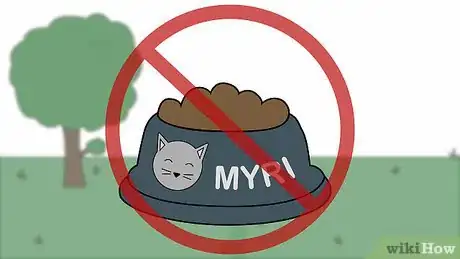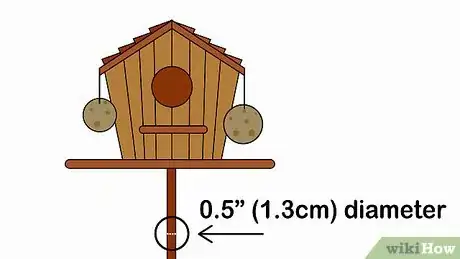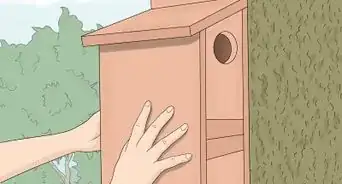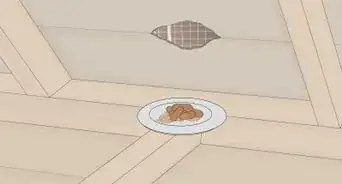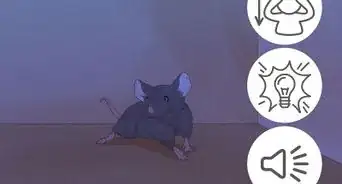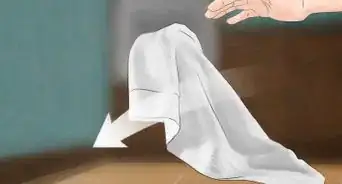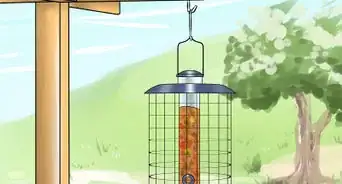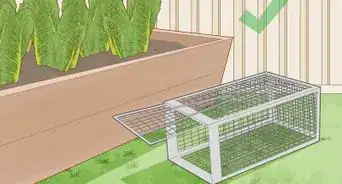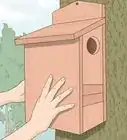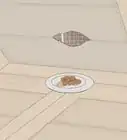This article was co-authored by Hussam Bin Break. Hussam Bin Break is a Certified Commercial Pesticide Applicator and Operations Manager. He and his brother Hussam co-founded Diagno Pest Control in the greater Philadelphia area in 2018, and have since expanded their services to include the New Jersey market. Diagno Pest Control has received Home Advisor's Top Rated and Elite Service Badges for quality of work and customer service.
There are 11 references cited in this article, which can be found at the bottom of the page.
wikiHow marks an article as reader-approved once it receives enough positive feedback. This article received 18 testimonials and 80% of readers who voted found it helpful, earning it our reader-approved status.
This article has been viewed 1,756,275 times.
Raccoons are cute to watch on TV, but they're not so cute when they leave your trash strewn all over your backyard. The good news is that you can use humane techniques to get rid of raccoons around your house. Make your trash cans unattractive or impossible to enter. Remove or prevent access to any potential food sources from your yard. Finally, block any areas that would allow raccoons to enter your home.
Steps
Keeping Raccoons Out of Your Trash
-
1Secure trash can lids. Use a rope, chain or bungee cord to tie the lid into a secure position. Alternatively, you could weigh down the lids with weights, bricks, or other heavy objects. Aim for about 20 pounds (9.1 kg) of weight to prevent the strongest adult raccoons from getting in.
- You could also purchase trash cans with latches or locks if they're within your budget.
-
2Clean out your trash cans. Wash them out with the hose every week or so. Sprinkle the inside with baking soda to remove any lingering food odors.[1] Tip them upside down so they don't store water for mosquitoes or for raccoons to drink.Advertisement
-
3Don't put out the trash at night. Raccoons are active at night, and trash cans are among their favorite “hunting grounds.” To prevent them from breaking into your trash, store your cans in the garage or other indoor location. Take them out to the curb the morning of your scheduled pickup.[2]
-
4Double bag food scraps. Raccoons have a very keen sense of smell that allow them to detect food sources from far away. Double bagging will help to contain food odors. This is especially helpful if you absolutely must keep your trash outside the night before the next garbage pickup.[3]
Removing Food Sources
-
1Clean up all food debris from your yard. Sweep up berries that fell from trees. Make sure that any picnic tables and chairs (or anything else outside) are completely free of food scraps and crumbs. Clean the area completely. Double check the area after you finish.[4]
-
2Pay attention to pet food. Raccoons are omnivores, so they won't pass up any dog- or cat food scraps left outdoors. You can avoid this problem entirely by feeding your companion animals indoors. If you must feed Fido or Tiger outside, clean up every last scrap of wet or dry food when meal time is over. If you have a doggie door or cat flap, keep food bowls far away from these access points.
-
3Keep bird feeders out of their reach. Even a bird feeder with sunflower seeds might be tempting to a raccoon. Hang your bird feeder on a pole about 0.5 inches (1.3 cm) in diameter. Raccoons can't climb such skinny poles. Secure the pole firmly so that it can't be knocked over. Store any bird seed in metal trash cans or an indoor locations that raccoons can't access.[5]
- If this isn't an option, lock up your bird feeder in the garage or tool shed just before sundown.
-
4Protect your fish pond. As omnivores, raccoons love to fish. Place cinder blocks, ceramic pipes, and wire baskets in the pond. These will provide hiding places for your fish. You can also install metal leaf netting over your fish pond. Buy the strongest material available to support the raccoon's weight.
Removing Access Points
-
1Identify points of entry. Inspect your house, garage, and fence. Look for holes 3 inches (7.6 cm) in diameter or bigger. Check downspouts for scratches and body oil stains where racoons might have been climbing. If they're in your attic, look under nooks, dormers, or broken vents. If you hear them in your crawl space, look for broken vents or borrows. It might also help to check for footprints, especially if recent rains have created muddy conditions.[6]
-
2Identify nesting areas. Raccoons don't use nesting materials like birds do. The only way to identify a nest is by the fecal matter they leave. Look for brown cylindrical objects with digested berries. Raccoon feces look similar to those left by small dogs. When in doubt, contact your local extension office.[7]
-
3Repel raccoons from entry points and nesting areas. Boil one cup of cayenne pepper and 3-5 chopped habanero chilis with water in a pot and let it cool. Transfer it into a spray bottle. Spray the entry points you've identified. Because raccoons follow their noses, this spray will make their nesting area unbearable.[8]
- Use goggles and a respirator before spraying in enclosed areas. Although hot peppers are technically non-toxic, they can irritate mucous membranes in your eyes and mouth.[9]
-
4Identify the main entry point. Check around your roof, foundation, or siding. Look for telltale signs like freshly dug holes, nesting materials, dirt stains, or hair stuck to the entry point. If the point of entry is in or near your foundation, you can also check for paw prints in the soil.
-
5Close off most points of entry. Make sure the raccoons have left the area before you seal off any openings. You're most likely to find an empty space if you start working between 8:00 and 11:00pm, when most raccoons are out scavenging.[10] Cover the entry points with 0.5 inches (1.3 cm) of wire meshing. Then, seal the mesh with a foam or caulking gun.
-
6Use newspaper on the main entry point. Wait until between 8:00 and 11:00pm. Stuff the newspaper lightly into the opening. Check the newspaper in the morning. If it's been moved, the raccoons might have left. Put it back in place. Continue to monitor the area for 48 hours. If the newspaper is still in place, you can permanently seal the hole.
- If it has been moved, the raccoon(s) might be back. Check if you're dealing with a mother and her young. If this is the case, let the young grow up so that the mother can move them on her own. If you find abandoned young, call your local wildlife rehabilitation center for assistance.
- If no young are on site, hire a professional to install a one-way door that will allow raccoons to exit but not re-enter.[11]
- Don't permanently block any vents with newspaper.
-
7Seal off your yard. Raccoons can easily scale wood or metal fences. They also use nearby tree limbs or shrubs to help them over fences. Run electrified wires at the top and bottom of your fence to deter intrusions. Prune tree limbs near fences.
- If you decide to replace your fence, make sure the mesh is no wider than 3 inches (7.6 cm). This will prevent young raccoons from entering your yard.
Expert Q&A
-
QuestionShould I get rid of raccoons?
 Hussam Bin BreakHussam Bin Break is a Certified Commercial Pesticide Applicator and Operations Manager. He and his brother Hussam co-founded Diagno Pest Control in the greater Philadelphia area in 2018, and have since expanded their services to include the New Jersey market. Diagno Pest Control has received Home Advisor's Top Rated and Elite Service Badges for quality of work and customer service.
Hussam Bin BreakHussam Bin Break is a Certified Commercial Pesticide Applicator and Operations Manager. He and his brother Hussam co-founded Diagno Pest Control in the greater Philadelphia area in 2018, and have since expanded their services to include the New Jersey market. Diagno Pest Control has received Home Advisor's Top Rated and Elite Service Badges for quality of work and customer service.
Pest Control Professional Yes, as long as it's not nesting season. If a raccoon finds an opening where it can get into your roof, it can cause big problems. Raccoons can transmit diseases, spread fleas, chew on your wires, and mess up your roof. One way to get rid of them is to install a one-way gate so they can get out but not back in again. However, it's best to do that in the season when raccoons don't have babies, because the babies can't walk for the first two months of their life.
Yes, as long as it's not nesting season. If a raccoon finds an opening where it can get into your roof, it can cause big problems. Raccoons can transmit diseases, spread fleas, chew on your wires, and mess up your roof. One way to get rid of them is to install a one-way gate so they can get out but not back in again. However, it's best to do that in the season when raccoons don't have babies, because the babies can't walk for the first two months of their life.
Warnings
- Never use chemicals to deter raccoons. You'll likely put other species at risk if you do.⧼thumbs_response⧽
- Check your local animal welfare laws before using any removal method. Breaking these laws can result in fines and jail time.⧼thumbs_response⧽
- If you need to scare off a raccoon in a pinch, try flashing a light or making a loud noise. Trying to approach or trap them can be dangerous.⧼thumbs_response⧽
- Beware of raccoon-borne diseases, such as rabies, distemper, roundworm, and leptospirosis. They can transfer these illnesses to you and/or your companion animals.[12]⧼thumbs_response⧽
References
- ↑ https://www.bobvila.com/articles/how-to-deodorize-trash-can/
- ↑ https://www.torontowildlifecentre.com/wildlife-emergency-rescue-hotline/conflicts-with-wildlife/common-raccoon-problems/raccoons-getting-in-garbage-and-compost-bins/
- ↑ https://www.bobvila.com/articles/how-to-get-rid-of-raccoons/
- ↑ http://extension.umd.edu/sites/extension.umd.edu/files/_images/programs/hgic/Publications/HG90%20Dealing%20with%20Nuisance%20Wildlife.pdf
- ↑ http://www.humanesociety.org/animals/raccoons/tips/raccoon_birdfeeders.html
- ↑ http://www.humanesociety.org/animals/raccoons/tips/raccoon_eviction_exclusion.html
- ↑ http://www.raccoonatticguide.com/droppingsfeces.html
- ↑ http://www.stepin2mygreenworld.com/healthyliving/tips-for-getting-rid-of-raccoons-with-natural-repellents/
- ↑ http://time.com/99236/what-happens-when-you-inhale-sriracha-fumes/
About This Article
To get rid of raccoons, secure the lid on your trash can with a lock or move it inside at night so the raccoons can't eat out of it. Also, double bag your trash so it's harder for the raccoons to smell it. If raccoons are eating out of your bird feeders, re-hang the feeders on skinny poles, which raccoons won't be able to climb. If all else fails, spray your yard and garden with a mixture of boiled water and hot chili peppers, which will irritate the raccoons and make them leave. To learn more about how to seal common entry points for raccoons, keep reading below!


